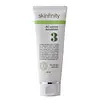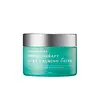What's inside
What's inside
 Key Ingredients
Key Ingredients

 Benefits
Benefits

 Concerns
Concerns

No concerns
 Ingredients Side-by-side
Ingredients Side-by-side

Water
Skin ConditioningDipropylene Glycol
HumectantCetearyl Alcohol
EmollientCyclopentasiloxane
EmollientCyclohexasiloxane
EmollientDimethicone
EmollientDimethyl Sulfone
SolventAmmonium Acryloyldimethyltaurate/Vp Copolymer
Batyl Alcohol
EmollientCetearyl Olivate
Sorbitan Olivate
EmulsifyingGlyceryl Stearate
EmollientPEG-100 Stearate
Sclerotium Gum
Emulsion StabilisingCarbomer
Emulsion StabilisingAllantoin
Skin ConditioningPyridoxine Hcl
Skin ConditioningSalix Alba Bark Extract
AstringentTromethamine
BufferingHydroxyacetophenone
AntioxidantButylene Glycol
HumectantGlycerin
HumectantMyrtus Communis Extract
AstringentTropaeolum Majus Extract
AntimicrobialZanthoxylum Piperitum Fruit Extract
Skin ConditioningPulsatilla Koreana Extract
Skin ConditioningUsnea Barbata Extract
Ethylhexylglycerin
Skin ConditioningAlanine
MaskingArginine
MaskingGlycine
BufferingGlutamic Acid
HumectantSerine
MaskingSciadopitys Verticillata Root Extract
AntimicrobialAloe Barbadensis Leaf Extract
EmollientCopper Tripeptide-1
Skin ConditioningParfum
MaskingWater, Dipropylene Glycol, Cetearyl Alcohol, Cyclopentasiloxane, Cyclohexasiloxane, Dimethicone, Dimethyl Sulfone, Ammonium Acryloyldimethyltaurate/Vp Copolymer, Batyl Alcohol, Cetearyl Olivate, Sorbitan Olivate, Glyceryl Stearate, PEG-100 Stearate, Sclerotium Gum, Carbomer, Allantoin, Pyridoxine Hcl, Salix Alba Bark Extract, Tromethamine, Hydroxyacetophenone, Butylene Glycol, Glycerin, Myrtus Communis Extract, Tropaeolum Majus Extract, Zanthoxylum Piperitum Fruit Extract, Pulsatilla Koreana Extract, Usnea Barbata Extract, Ethylhexylglycerin, Alanine, Arginine, Glycine, Glutamic Acid, Serine, Sciadopitys Verticillata Root Extract, Aloe Barbadensis Leaf Extract, Copper Tripeptide-1, Parfum
Water
Skin ConditioningCyclopentasiloxane
EmollientButylene Glycol
HumectantGlycerin
HumectantCyclohexasiloxane
EmollientNiacinamide
Smoothing1,2-Hexanediol
Skin ConditioningChamaecyparis Obtusa Water
MaskingHydroxyacetophenone
AntioxidantAmmonium Acryloyldimethyltaurate/Vp Copolymer
Dimethicone
EmollientCaprylyl Glycol
EmollientPolyacrylate-13
Carbomer
Emulsion StabilisingArginine
MaskingPolyisobutene
Panthenol
Skin ConditioningXanthan Gum
EmulsifyingAllantoin
Skin ConditioningEthylhexylglycerin
Skin ConditioningAdenosine
Skin ConditioningCitrus Aurantium Bergamia Fruit Oil
MaskingDisodium EDTA
Polysorbate 20
EmulsifyingSorbitan Isostearate
EmulsifyingDipropylene Glycol
HumectantSodium Hyaluronate
HumectantAloe Barbadensis Leaf Extract
EmollientPortulaca Oleracea Extract
Skin ConditioningMelia Azadirachta Leaf Extract
Skin ConditioningCentella Asiatica Extract
CleansingOcimum Sanctum Leaf Extract
Skin ConditioningAmber Powder
Corallina Officinalis Extract
Skin ConditioningMelia Azadirachta Flower Extract
Skin ConditioningCurcuma Longa Root Extract
MaskingCoccinia Indica Fruit Extract
Skin ConditioningMoringa Oleifera Seed Oil
EmollientSolanum Melongena Fruit Extract
Skin ConditioningErythritol
HumectantBisabolol
MaskingMadecassoside
AntioxidantPolyquaternium-51
Skin ConditioningMelaleuca Alternifolia Leaf Extract
PerfumingHouttuynia Cordata Extract
Skin ConditioningAsiaticoside
AntioxidantHizikia Fusiforme Extract
Skin ConditioningChlorella Vulgaris Extract
Skin ConditioningCodium Fragile Extract
Skin ConditioningUlva Lactuca Extract
Skin ConditioningMacrocystis Pyrifera Extract
Skin ConditioningFucus Vesiculosus Extract
EmollientLaminaria Cloustoni Extract
Skin ProtectingLaminaria Japonica Extract
Skin ProtectingGelidium Cartilagineum Extract
Skin ProtectingSalix Alba Bark Extract
AstringentPentylene Glycol
Skin ConditioningMentha Piperita Leaf Extract
Skin ConditioningMentha Suaveolens Leaf Extract
AstringentMentha Viridis Leaf Extract
MaskingWater, Cyclopentasiloxane, Butylene Glycol, Glycerin, Cyclohexasiloxane, Niacinamide, 1,2-Hexanediol, Chamaecyparis Obtusa Water, Hydroxyacetophenone, Ammonium Acryloyldimethyltaurate/Vp Copolymer, Dimethicone, Caprylyl Glycol, Polyacrylate-13, Carbomer, Arginine, Polyisobutene, Panthenol, Xanthan Gum, Allantoin, Ethylhexylglycerin, Adenosine, Citrus Aurantium Bergamia Fruit Oil, Disodium EDTA, Polysorbate 20, Sorbitan Isostearate, Dipropylene Glycol, Sodium Hyaluronate, Aloe Barbadensis Leaf Extract, Portulaca Oleracea Extract, Melia Azadirachta Leaf Extract, Centella Asiatica Extract, Ocimum Sanctum Leaf Extract, Amber Powder, Corallina Officinalis Extract, Melia Azadirachta Flower Extract, Curcuma Longa Root Extract, Coccinia Indica Fruit Extract, Moringa Oleifera Seed Oil, Solanum Melongena Fruit Extract, Erythritol, Bisabolol, Madecassoside, Polyquaternium-51, Melaleuca Alternifolia Leaf Extract, Houttuynia Cordata Extract, Asiaticoside, Hizikia Fusiforme Extract, Chlorella Vulgaris Extract, Codium Fragile Extract, Ulva Lactuca Extract, Macrocystis Pyrifera Extract, Fucus Vesiculosus Extract, Laminaria Cloustoni Extract, Laminaria Japonica Extract, Gelidium Cartilagineum Extract, Salix Alba Bark Extract, Pentylene Glycol, Mentha Piperita Leaf Extract, Mentha Suaveolens Leaf Extract, Mentha Viridis Leaf Extract
 Reviews
Reviews

Ingredients Explained
These ingredients are found in both products.
Ingredients higher up in an ingredient list are typically present in a larger amount.
Allantoin is a soothing ingredient known for its protective and moisturizingg properties. Because of this, it is often added to products with strong active ingredients.
Studies show higher concentrations of this ingredient can promote wound healing.
Though it can be derived from the comfrey plant, allantoin is produced synthetically for cosmetic products to ensure purity.
Learn more about AllantoinAloe Barbadensis Leaf Extract is an extract of the leaves of the aloe, Aloe barbadensis, Liliaceae.
Aloe is one of the most well-known natural soothing ingredients, and for good reason. It’s full of water and has a cooling, calming effect on the skin, especially when it’s sunburned, itchy, or irritated. Aloe also helps your skin stay hydrated and smooth by mimicking what healthy skin naturally produces. On top of that, it contains vitamins and nutrients that support skin recovery.
It doesn’t protect you from the sun, but it can help your skin bounce back after too much time in it.
Let’s get into the details:
Aloe contains antioxidant Vitamins A, C, and E, which help fight off free radicals (unstable molecules from things like pollution that can damage your skin).
It’s also rich in polysaccharides, which are natural sugars that help hydrate the skin by acting like the skin’s own moisturizing agents. These, along with other sugars like monosaccharides, help form a protective barrier that locks in moisture.
Aloe works as both a humectant and an emollient. That means it draws water into the skin (humectant) and helps trap it there (emollient), making it an effective natural moisturizer.
You’ll also find a mix of other skin-supporting ingredients in aloe, including folic acid, choline, calcium, amino acids, fatty acids, and even Vitamin B12.
Out of the 420+ species of aloe, Aloe barbadensis is the most widely used in skincare products thanks to its gentle yet effective properties.
There are over 420 species of aloe but Aloe Barbadensis is the most commonly used for topical products.
Learn more about Aloe Barbadensis Leaf ExtractAmmonium Acryloyldimethyltaurate/Vp Copolymer (let's call it AAVC for short) is a synthetically created polymer. It's used as a film-forming agent and used to thicken the consistency of products.
AAVC is able to increase the consistency and viscosity of products due to its large molecule size. It also prevents ingredients from separating.
Arginine is an amino acid that is important for human development. Your body uses is it to produce hair keratin and skin collagen.
As a cosmetic ingredient, Arginine has antioxidant properties and can also help repair damaged skin. This ingredient is derived either synthetically or from animals.
Arginine isn't fungal acne safe when used in the presence of other lipids (fats, fatty acids, oils, esters, etc). Oils and fats occur naturally within the skin, so take caution when using Arginine if you're prone to fungal acne.
Learn more about ArginineButylene Glycol (or BG) is used within cosmetic products for a few different reasons:
Overall, Butylene Glycol is a safe and well-rounded ingredient that works well with other ingredients.
Though this ingredient works well with most skin types, some people with sensitive skin may experience a reaction such as allergic rashes, closed comedones, or itchiness.
Learn more about Butylene GlycolCarbomer is a polymer of acrylic acid. Its main role is to create a gel consistency.
A high amount of carbomer can cause pilling or balling up of products. Don't worry, most products contain 1% or less of carbomer.
Cyclohexasiloxane is a type of silicone more commonly known as D6. It is an emollient and solvent.
Cyclohexasiloxane is used to evenly distribute ingredients throughout the product. When applied to the skin, Cyclohexasiloxane evaporates and leaves behind a silky feel.
As an emollient, it can help the skin feel soft and hydrated. It is also used to reduce frizz in hair products.
Learn more about CyclohexasiloxaneCyclopentasiloxane, or D5, is a silicone used to improve texture of products and trap moisture.
D5 is considered lightweight and volatile. Volatile means it evaporates quickly after application. Once evaporated, D5 leaves a thin barrier that helps keep skin hydrated.
It is also an emollient. Emollients help soften the skin and prevent water loss. Silicones create a silky texture in products. D5 helps other ingredients become more spreadable.
Studies show D5 is safe to use in skincare products. We recommend speaking with a skincare professional if you have concerns.
Learn more about CyclopentasiloxaneDimethicone is a type of synthetic silicone created from natural materials such as quartz.
What it does:
Dimethicone comes in different viscosities:
Depending on the viscosity, dimethicone has different properties.
Ingredients lists don't always show which type is used, so we recommend reaching out to the brand if you have questions about the viscosity.
This ingredient is unlikely to cause irritation because it does not get absorbed into skin. However, people with silicone allergies should be careful about using this ingredient.
Note: Dimethicone may contribute to pilling. This is because it is not oil or water soluble, so pilling may occur when layered with products. When mixed with heavy oils in a formula, the outcome is also quite greasy.
Learn more about DimethiconeDipropylene Glycol is a synthetically created humectant, stabilizer, and solvent.
This ingredient helps:
Dipropylene glycol is technically an alcohol, but it belongs to the glycol family (often considered part of the ‘good’ alcohols). This means it is hydrating and gentle on skin unlike drying solvent alcohols like denatured alcohol.
As a masking agent, Dipropylene Glycol can be used to cover the smell of other ingredients. However, it does not have a scent.
Studies show Dipropylene Glycol is considered safe to use in skincare.
Learn more about Dipropylene GlycolEthylhexylglycerin (we can't pronounce this either) is commonly used as a preservative and skin softener. It is derived from glyceryl.
You might see Ethylhexylglycerin often paired with other preservatives such as phenoxyethanol. Ethylhexylglycerin has been found to increase the effectiveness of these other preservatives.
Glycerin is already naturally found in your skin. It helps moisturize and protect your skin.
A study from 2016 found glycerin to be more effective as a humectant than AHAs and hyaluronic acid.
As a humectant, it helps the skin stay hydrated by pulling moisture to your skin. The low molecular weight of glycerin allows it to pull moisture into the deeper layers of your skin.
Hydrated skin improves your skin barrier; Your skin barrier helps protect against irritants and bacteria.
Glycerin has also been found to have antimicrobial and antiviral properties. Due to these properties, glycerin is often used in wound and burn treatments.
In cosmetics, glycerin is usually derived from plants such as soybean or palm. However, it can also be sourced from animals, such as tallow or animal fat.
This ingredient is organic, colorless, odorless, and non-toxic.
Glycerin is the name for this ingredient in American English. British English uses Glycerol/Glycerine.
Learn more about GlycerinHydroxyacetophenone is antioxidant with skin conditioning and soothing properties. It also boosts the efficiency of preservatives.
This ingredient is not irritating or sensitizing.
Salix Alba Bark Extract comes from the white willow tree, which is native to Europe and Central Asia.
Salix Alba Bark Extract has often been described as salicylic acid's cousin. This is due to the salicin it contains. However, studies are limited showing salix alba bark to be an effective salicylic acid alternative.
Salicin does have anti-inflammatory and antioxidant properties. It has shown to decrease the formation of inflammatory mediators, such as tumor necrosis factor-α and nuclear factor-kappa B. Salicin also has a mildly exfoliating effect on the skin.
Several other components in salix alba bark extract also contain antioxidant properties, such as flavonoids and polyphenols. Antioxidants may help with anti-aging as they neutralize harmful free-radical molecules.
Willow Bark extract has been used for thousands of years. Ancient civilizations used white willow to help treat pain and fevers.
Learn more about Salix Alba Bark ExtractWater. It's the most common cosmetic ingredient of all. You'll usually see it at the top of ingredient lists, meaning that it makes up the largest part of the product.
So why is it so popular? Water most often acts as a solvent - this means that it helps dissolve other ingredients into the formulation.
You'll also recognize water as that liquid we all need to stay alive. If you see this, drink a glass of water. Stay hydrated!
Learn more about Water